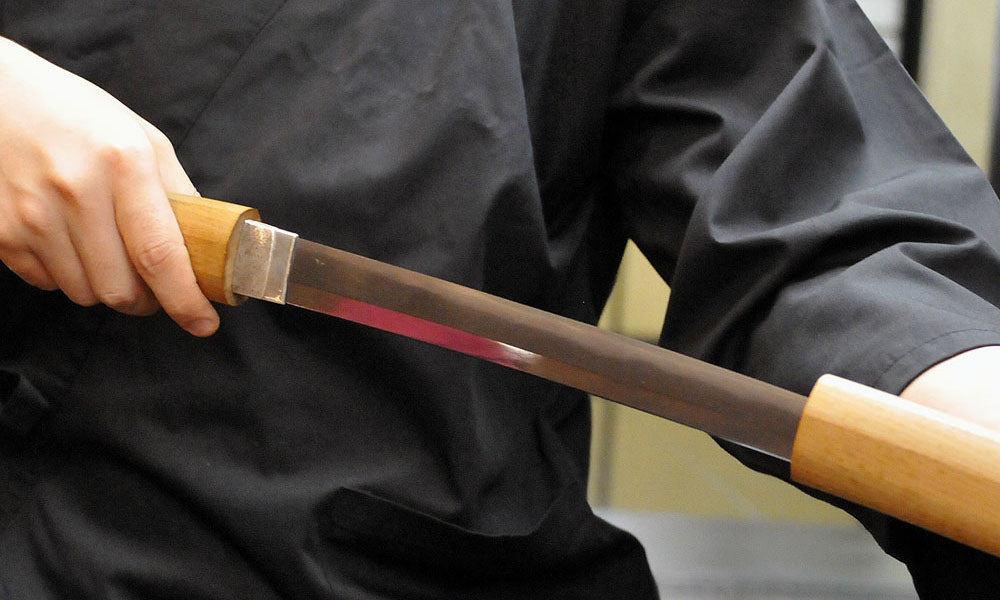How to draw and sheath your Japanese sword
It goes without saying, that Japanese swords are precious cultural treasures, but if it is handled roughly it might be damaged or might cause injury to yourself or someone else. If that happens, the value of such a precious treasure might be lost and we don't want to embarrass our ancestors do we? Because of that, we should pay the utmost attention and respect when handling and owning such swords.
Handling precautions
Whether your Japanese sword is being preserved in a shirasaya (a simple wooden scabbard and hilt for storage purposes) or mounted as a koshirae (ornamental/practical mount), it should always be stored in a sword bag.

When you put it in the sword bag, you usually put it in with the kojiri (the end of the scabbard) first, this is to prevent you from getting hurt in the case the sword unexpectedly slips out from the saya (the scabbard).

Hold a sword in your right hand, with the tsuka (hilt) facing upwards. The blade's tip should face down towards the ground.
When carrying your sword, be sure to carry it in your right hand, with the tsuka facing upwards and the tip of the blade facing down towards the ground, this is also to prevent the sword from slipping out from the saya and hurting you or someone else while you carry it around. Of course, also when you take out the sword from the bag or draw it, make sure that you do not do it while the tsuka is facing downwards to prevent unexpected injury in case of slippage.
How to draw the sword and sheath it

Always start with a bow and end with a bow.
First of all, we pay our respects to the sword by bowing to it. As a general rule, it’s considered good manners to remove any jewelry, including watches, other precious metals, and gemstones you are wearing prior to handling the sword.

Grip the saya with your left hand from underneath with the cutting edge facing upwards and grip the tsuka with your right hand from above. Make sure to pull the tsuka gently.
When drawing the sword, no matter if it is a tachi or a katana, you grip the saya with your left hand from underneath with your fingers supporting the mune (opposite side to the cutting edge) of the saya and with the cutting edge facing upwards, while your right-hand grips the tsuka from above with your fingers resting on the ha (cutting-edge) side of the tsuka and gently pull out the sword from the saya.
If you use too much strength to pull it out, you might damage the koiguchi (the mouth of the saya) and in the recoil, you might injure yourself if you are not careful, so to start with; slowly and quietly pull out the sword so that only the habaki (the metallic part that locks the sword inside the saya) becomes visible. This action is called koiguchi wo kiru; cutting the koiguchi.
Slowly and carefully pull out the blade of the sword while paying attention as to not rattling the blade inside of the saya. When pulling out the blade, do not hold the sword with the cutting edge facing downwards or sideways to avoid unfortunate accidents.

When sheathing the sword, do it slowly but surely.
When you sheath the sword, you grip the saya and the tsuka in the same way as when you draw it, your left hand should grip the saya from underneath with the fingers supporting the mune of the Saya, and the right hand should grip the tsuka from above with the fingers resting on the blade side of the tsuka. Gently bring the tip of the blade to the koiguchi with the cutting edge facing upwards and slide the sword into the saya, allowing the back of the blade to gently follow the shape of the saya to prevent the blade from rattling.
Once the blade is sheathed, firmly push the habaki part inside the saya to properly sheath the sword. When doing this you should of course not hold the sword with the blade facing downwards or sideways either to prevent accidents. So there you have it, a complete guide to a careful and respectful way of drawing and sheathing your sword when wanting to perform maintenance or inspections.

Want to buy authentic Samurai swords directly from Japan? Then TOZANDO is your best partner!

Leave a comment: